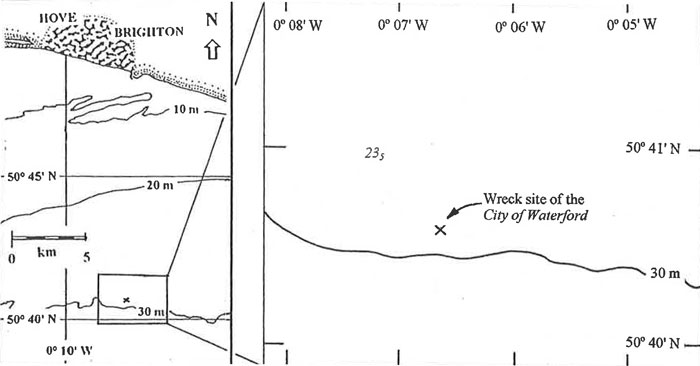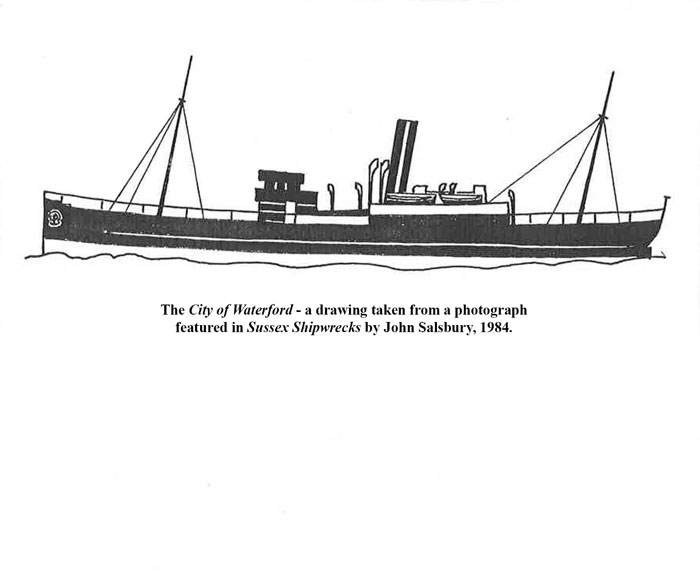SUSSEX MARINE SITES OF NATURE CONSERVATION IMPORTANCE
| Site: City of Waterford wreck | Ref. No. 20 | ||||||
| Location: 15 km S of Brighton Marina | Other conservation designation?: No |
||||||
| Lat./Long. position of centre of site: 50° 40' 57" N 0° 6' 69" W |
OS grid ref. of centre of site: TV 334 880 |
Author: Robert Irving |
|||||
| Sea bed type: Metal plates & superstructure lying proud of surrounding seabed of sand and gravel. |
Depth range (below chart datum): 23-29 m |
Date identified: June 2001 |
|||||
Summary
The City of Waterford was a 1,258 ton British steamer built in 1921 in the Clyde (and originally named Skerries II), which sank in 1949 after a collision with a Greek steamer in thick fog. She now sits upright on the seabed with a slight list to port, the shallowest part of her superstructure being at 23 m BCD with the seabed at 29 m BCD. She makes a popular deep water wreck dive for many of the local diving clubs.
Biological Description
Much of the superstructure of the wreck is covered by marine life. Fauna recorded from the wreck includes various crustaceans (for example lobster Homarus vulgaris, edible crab Cancer pagurus, spider crab Maja squinado and swimming crabs), patches of mussels Mytilus edulis, clumps of the hydroid Nemertesia antennina and occasional sea anemones and dead man's fingers Alcyonium digitatum. Arguably, the main biological interest on the wreck is the presence of variously coloured patches of jewel anemones Corynactis viridis on vertical metal plates. These patches have been described as being 0.5-1.0 m2 in size, with green, pink/purple and orange colour morphs being conspicuous. Jewel anemones are commonly found along the western seaboard of the British Isles, though are rare this far east along the English Channel. Indeed, this is the furthest east they have been recorded.
The fish life on and around the wreck is prolific, the wreck providing shelter and food for a wide variety of species. In particular, large numbers of big individuals have been noted (this despite it being a popular site for anglers too). The following fishes have been recorded from the site: conger eel Conger conger (common); bass Dicentrarchus labrax (numerous at times); pollack Pollachius pollachius (common and usually very large individuals); cod Gadus morhua (common, though not so much in recent years); bib Trisopterus luscus (abundant); brill Scophthalmus rhombus (rare though difficult to spot); plaice Pleuronectes platessa (common); lemon sole Microstomus kitt (occasional); Dover sole Solea solea (common); and black sea bream Spondyliosoma cantharus (possibly common at certain times of year).
The surrounding seabed, at 29 m BCD, is of sand and gravel.
Justification
Many shipwrecks litter the seabed off the Sussex coast in varying states of decay. The City of Waterford is a particularly good example of a 'modern' shipwreck which lies in deep water in a largely intact state. The marine life associated with the wreck is 'typical' for this part of the country. The main biological interest is that this is thought to be the furthest east the jewel anemone Corynactis viridis is found in the English Channel.
References:Irving, R. A. 1999. Report of the Sussex Seasearch Project, 1992-1998 Sussex SEASEARCH Project, English Nature, Lewes, and Brighton & Hove Council, Brighton |
|||||||
| Sussex SEASEARCH dive nos.: 714/71 & 716/12 | |||||||
Site Location

Diagrammatic representation of site: City of Waterford wreck


:Link to this page
Copyright Sussex Biodiversity Records Centre © 2025